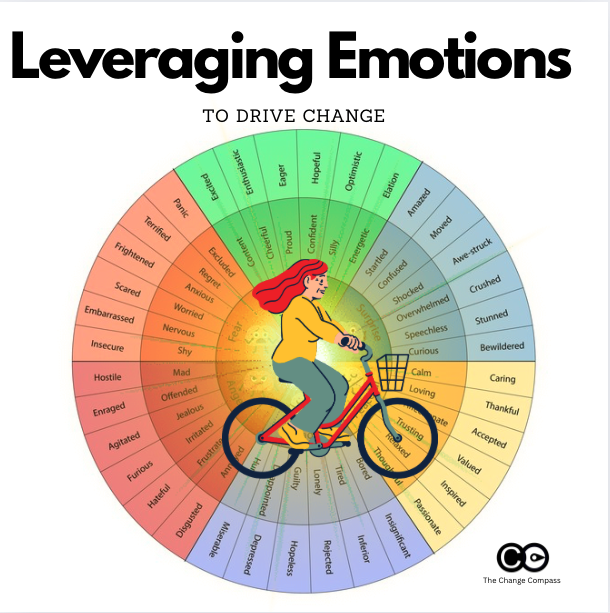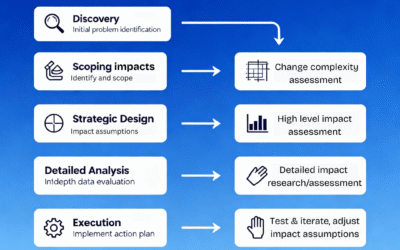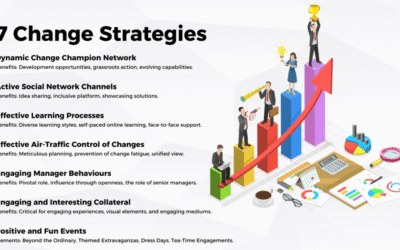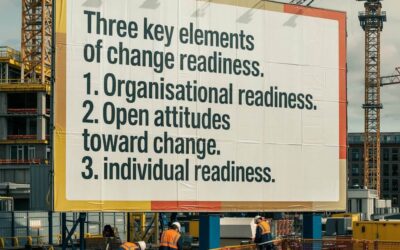Change and transformation initiatives rarely fail for lack of strategy or technical expertise – they falter when leaders underestimate the emotional dimension of change. For seasoned professionals driving organization-wide transformation, understanding how to engage the hearts and minds of employees is the difference between short-lived compliance and deep, sustainable commitment.
The Power of Emotions in Motivating Change
To motivate significant change, it is essential to go beyond the rational case and touch the hearts of employees by appealing to what truly matters to them and what they feel strongly about. Research consistently shows emotionally intelligent leaders are more successful at driving change. One study notes that leaders with high EI are more likely to drive successful change initiatives than those with lower emotional awareness. Leaders who understand their own emotions and those of their teams can inspire, align, and energize people far more effectively than leaders relying solely on logic and process.
Why Emotional Resonance Is Essential
- People are moved to action by what they care about. Logic justifies, but emotion compels action. Employees must see the personal significance of change – how it relates to their values, goals, and hopes.
- Emotions shape perception of risk and opportunity. Change often triggers uncertainty and ambiguity, which are interpreted emotionally before logically.
- Emotional connection breeds trust and reduces resistance. Employees are more open to change when they feel understood and valued by leaders they trust.
Infusing the Change Journey with a Range of Emotions
Rather than viewing negative emotions as obstacles and positive emotions as side effects, the most effective leaders intentionally inject a spectrum of emotions across the change journey to drive engagement and build resilience.
Key emotions to strategically leverage include:
- Excitement: To create early momentum and interest.
- Curiosity: To encourage exploration, learning, and openness to new ideas.
- Hope: To sustain long-term belief in the value and attainability of change.
- Contentment and Relief: To mark progress, celebrate milestones, and reduce fatigue.
- Amusement and Awe: To humanize the process, provide psychological relief, and highlight significant achievements or breakthroughs.
Each phase of change management – from initial awareness to adoption and reinforcement – presents opportunities to leverage different emotions that collectively build engagement and adaptability.
Example Applications
- Kick-off communications: Stir excitement and curiosity by spotlighting new opportunities, challenges, and the bigger “why.”
- Development stages: Use hope and inclusion, showing progress and involving teams in solution-finding.
- Launch and transition: Celebrate success, recognize effort, and use amusement (e.g., gamified elements) to keep spirits high amidst disruption.

Emotions as a Strategic Lever for Change Leaders
Transformational leaders understand that orchestrating change means intentionally managing and harnessing emotions, not suppressing or ignoring them. By tuning into emotional undercurrents, leaders can:
- Detect subtle signs of resistance or fatigue early.
- Celebrate emotional wins, not just operational ones.
- Adapt messages and interventions to journey stages and emotional climate.
- Model openness, normalizing emotional conversations within professional spaces.
Emotional intelligence is thus not a “soft” skill, but a strategic lever – “a must-have asset for those leading change initiatives,” as highlighted in leading change management research.
Managing and Addressing Negative Emotions to Sustain Change
Leading successful organizational transformation requires more than amplifying positive emotions; it necessitates the proactive recognition and management of negative emotions that naturally surface during times of change. For senior change and transformation professionals, skilfully navigating this emotional terrain is fundamental to minimizing resistance, reducing risk, and supporting sustainable behaviour change.
Negative Emotions: Predictable, Powerful, and Manageable
Significant change – even when ultimately beneficial – disrupts established routines, identity, and psychological safety. Anxiety, fear, stress, anger, guilt, disappointment, and similar emotions are not anomalies; they are predictable responses rooted in uncertainty and perceived loss. Ignoring or dismissing these emotions increases the likelihood of disengagement, resistance, or project failure.
Why Negative Emotions Matter
- Change is experienced subjectively. Even positive shifts generate discomfort as people relinquish familiarity and control.
- Unaddressed negative emotions magnify resistance. If left unmanaged, anxiety and fear can evolve into cynicism, mistrust, or apathy.
- Negative emotions can serve as signals. They often highlight real obstacles (lack of understanding, perceived injustice, capacity constraints) that demand attention.
Core Approaches to Managing Negative Emotions
- Surface and Validate Emotions Early
- Encourage open dialogue about fears, frustrations, and uncertainties.
- Normalize emotional reactions by acknowledging that these are shared and expected responses to change.
- Create Psychological Safety
- Foster an environment where employees feel safe expressing concern and doubt without fear of retribution.
- Equip managers with tools and language to hold empathetic conversations and demonstrate genuine care.
- Targeted Communication and Transparency
- Address the why behind change – and spell out the risks of staying the same as well as the intended benefits.
- Clarify what is not changing to provide anchors of stability.
- Share updates honestly; trust is maintained by admitting what is unknown or still evolving.
- Provide Resources for Coping and Adjustment
- Offer training and practical support to build the competence and confidence needed to adapt.
- Promote peer support networks and employee assistance programs focused on emotional well-being.
- Monitor and Respond to Hot Spots
- Use quantitative (pulse surveys, sentiment analysis) and qualitative (focus groups, direct feedback) methods to identify departments or groups experiencing heightened stress, anger, or disengagement.
- Intervene promptly: tailor strategies (coaching, workload adjustment, additional support) to the specific root causes surfaced.
Practical Example: Driving Compliance Change
Consider a regulatory compliance initiative requiring strict behavioural shifts. Some employees may react with resistance, resentment, or guilt over past practices. The leader’s role is to:
- Clearly communicate the rationale (“why this matters”), using real-world consequences rather than just abstract directives.
- Create opportunities for employees to voice concerns, ask questions, and seek clarification.
- Provide a safe pathway for adaptation – acknowledging initial frustration while offering positive reinforcement and practical support as new behaviours are adopted.
- Recognize and celebrate progress, even when small, helping shift the emotional story from “mandated pain” to “shared achievement” over time.
Leveraging Negative Emotions as Catalysts
At times, driving behaviour change may involve activating negative emotions briefly to disrupt complacency and spur action. For example:
- Highlighting risks and consequences can use fear productively to achieve urgency.
- Allowing discomfort during difficult reflections (e.g., on ethical or compliance gaps) to motivate honest self-appraisal and commitment to new standards.
However, expert leaders then quickly pivot towards hope, support, and a shared vision, ensuring negative emotions serve as catalysts rather than chronic obstacles.
The Role of Senior Leaders: Empathy, Agency, and Boundaries
Senior leaders modelling vulnerability and self-regulation are essential. They:
- Empathize openly with teams facing anxiety, stress, or loss.
- Set clear boundaries for expected behaviours while also communicating flexibility in adaptation paths.
- Use their own emotional intelligence to intervene early – elevating what’s working and constructively addressing blocks.
Measuring and Managing Emotional Impact
- Regularly track employee sentiment to spot growing pockets of overwhelm or anger.
- Use behavioural markers (e.g., engagement levels, change adoption rates, incident reports) to triangulate emotional health.
- Deploy targeted interventions – adjusting timelines, providing additional resources, or recalibrating expectations – to mitigate chronic negative emotional load.
As discussed, negative emotions are not inherently “bad.” When surfaced, addressed, and used purposefully, they become signals and even agents of necessary transformation.
Monitoring Emotional Signals, Using Data, and Modulating Change for Sustainable Success
Delivering transformation at scale isn’t just a matter of visionary leadership and responsive management – it requires robust, ongoing mechanisms to listen to, measure, and respond to the emotional currents within your organization. In a world where the pace, complexity, and uncertainty of change are unrelenting, senior change and transformation professionals must treat emotional management as an integrated, data-driven discipline.
Systematically Monitoring Employee Sentiment
Modern change leadership goes beyond intuition and anecdotal evidence. To ensure lasting adoption and minimize emotional fatigue, organizations must deliberately monitor employee sentiment throughout the change journey. This involves using both qualitative and quantitative approaches:
Quantitative Tools
- Pulse Surveys: These regular, short surveys quickly capture shifting moods and concerns. Questions can focus on confidence in the change, perceived impact, stress levels, and sense of involvement.
- Sentiment Analysis: Analysing words and phrases in internal communications (e.g., survey responses, emails, chat forums) can provide a broader, real-time picture of organizational mood.
- Engagement Metrics: Analysing participation rates in change-related forums, training modules, and events offers clues to energy, buy-in, and resistance.
Qualitative Signals
- Focus Groups and Open Forums: Small-group discussions allow deeper exploration of emotional drivers, uncovering underlying issues not surfaced in surveys.
- Leader Check-Ins: Regular, open conversations between managers and team members provide space for direct feedback, concerns, and suggestions.
- Observation of Behaviours: Changes in productivity, absenteeism, collaboration, or informal communication patterns can signal rising stress or disengagement.
These monitoring tools aren’t just diagnostic; they are intervention triggers, providing data to adjust the pace, content, and support structure of your change efforts.
Using Data to Manage Change Stress and Adapt Strategy
The volume, velocity, and cumulative impact of simultaneous change initiatives (often called “change saturation”) are major contributors to employee stress and emotional overload. Without hard data, leaders risk pushing teams past breaking point or missing signs of silent disengagement. With data, leaders can:
- Identify At-Risk Groups: Data might reveal a specific business unit showing sharp increases in stress or declines in engagement, warranting targeted support or pacing adjustments.
- Monitor Change Readiness: By tracking readiness markers (self-assessed confidence, perceived adequacy of training, clarity of roles), leaders spot where additional communication or upskilling is needed.
- Triangulate Qualitative and Quantitative Insights: Married together, these data sources validate concerns and prevent rash conclusions from isolated anecdotes.
Practical actions could include:
- Staggering change roll-outs for overloaded teams.
- Providing extra resources or temporary relief for units under strain.
- Adjusting expectations or timelines when signs of emotional burnout emerge.
Moderating the Volume of Change
It is now well-established that organizations don’t fail from “change incapacity” but from unmanaged change saturation. Leaders must make strategic decisions about how much change the organization, and specific groups, can absorb at once. This means:
- Maintaining a Change Portfolio View: Map all concurrent changes affecting each employee group to avoid overlap and collision.
- Pausing or Sequencing Initiatives: Delay less urgent projects if sentiment or adoption data suggest people are stretched too thin.
- Prioritizing High-Impact Efforts: Focus energy on the few changes that truly matter, reducing “noise” and amplifying clarity.
Deliberate modulation of change volume – supported by real-time emotional and performance feedback – ensures that energy and positivity are not drowned out by chronic overwhelm.
Leveraging Emotional Intelligence – The Leader’s Ongoing Responsibility
Great change leaders constantly model emotional transparency, empathy, and resilience. But they also harness data and employee signals to:
- Acknowledge All Emotions: Routinely communicate about both positive and negative experiences, recognizing the reality of stress, pride, frustration, and hope within the journey.
- Elevate Successes and Learnings: Celebrate milestones publicly and use stories of difficulty overcome to build confidence and shared identity.
- Recalibrate Quickly: Show willingness to adjust approach based on feedback, which builds psychological safety and trust.
In this way, leaders shape not just the process but the collective emotional journey – moving the organization from mere compliance to ownership and advocacy.
Behavioural Signals: Tracking Readiness and Adoption
Emotional monitoring must be paired with vigilant observation of behavioural adoption. The ultimate goal is not just feeling better about change, but actually embedding new ways of working. Leaders should:
- Track participation rates in new processes, training, or systems.
- Observe peer-to-peer advocacy – do employees champion the change organically?
- Routinely assess performance metrics and qualitative feedback for signs of embedded change or reversion to old habits.
Where behavioural adoption lags, revisit the emotional journey – are people experiencing unresolved anxiety, lack of hope, insufficient relief, or overly prolonged stress?
The Emotional Science of Lasting Change
Seasoned change and transformation professionals know that successful change is as much an emotional journey as it is a strategic or operational one. Organizations that put emotional monitoring, data-driven adaptation, and emotionally intelligent leadership at the core of their change efforts improve not just adoption rates, but employee well-being and long-term resilience.
By appealing to what matters most, systematically addressing and harnessing the full spectrum of emotions, leveraging both human insight and hard data, and moderating the pace and load of change, leaders create a climate where people aren’t just surviving change – they’re thriving through it.
This is the new mandate for transformational leadership: bring science and heart together, and make emotions a central lever of lasting change.






